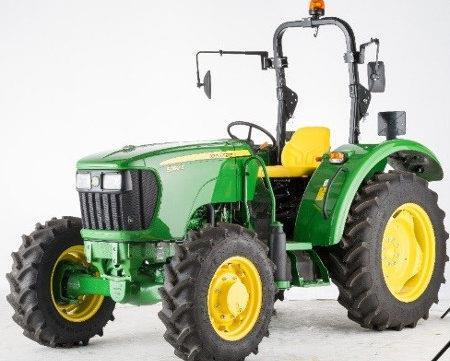


John Deere Agriculture
5050E, 5055E, 5065E and 5075E Tractors
TECHNICAL MANUAL
5055E, 5065E, 5075E, 5050E
TM900319, July 2013
Table of contents
FOREWORD
Section 10 - GENERAL INFORMATION
Group 05 - Safety
Group 10 - General Specifications
Group 20 - Fuel and Lubricants
Group 25 - Serial Number Locations
Group 30 - Features and Accessories
Section 20 - ENGINE REPAIR
Group 05 - Engine
Group 10 - Cylinder Head and Valves
Group 15 - Cylinder Block, Liners, Pistons and Rods
Group 20 - Crankshaft, Main Bearings and Flywheel
Group 25 - Camshaft and Timing Gear Train
Group 30 - Lubrication System
Group 35 - Cooling System
Section 30 - FUEL AND AIR INTAKE SYSTEM REPAIR
Group 05 - Fuel System
Group 10 - Air Intake and Exhaust System
Group 15 - Speed Control Linkage
Section 40 - ELECTRICAL REPAIR
Group 05 - Battery, Starter and Alternator
Group 10 - Electrical System Components
Group 15 - Wiring Harness
Section 50 - POWER TRAIN REPAIR
Group 05 - Clutch Housing
Group 10 - Clutch Assembly
Group 15 - Transmission
Group 20 - Rear PTO Drive Shaft
Group 25 - Differential
Group 30 - Final Drives
Group 35 - Mechanical Front Wheel Drive – If Equipped
Section 60 - STEERING AND BRAKE REPAIR
Group 05 - Steering Repair
Group 10 - Brake Repair
Section 70 - HYDRAULIC REPAIR
Group 05 - Hydraulic Pump and Filter
Group 10 - JD Rockshaft
Group 15 - Selective Control Valve (SCV)
Section 80 - MISCELLANEOUS REPAIR
Group 05 - Front Axle
Group 10 - Wheels
Group 15 - 3-Point Hitch
Group 20 - Hood
Group 25 - Ballast
Section 90 - OPERATOR STATION REPAIR
Group 05 - Seat and Support
Group 06 - Right Console
Group 10 - Roll-GardRoll-Gard is a trademark of Deere & Company.
Group 15 - Center Console
Group 20 - Operator Station
Group 25 - Fenders
Section 210 - OPERATIONAL CHECKOUT PROCEDURES
Group 10 - Operational Checkout Procedures
Section 220 - ENGINE OPERATION, TESTS AND ADJUSTMENTS
Group 05 - Component Location
Group 10 - Theory of Operation
Group 15 - Diagnosis, Tests and Adjustments
Section 230 - FUEL/AIR OPERATION, TESTS AND ADJUSTMENTS
Group 05 - Component Location
Group 10 - Theory of Operation
Group 15 - Diagnosis, Tests and Adjustments
Section 240 - ELECTRICAL SYSTEM OPERATION, TESTS AND ADJUSTMENTS
Group 05 - Component Location
Group 10 - Theory of Operation
Group 15 - Diagnosis, Tests and Adjustments
Group 20 - Wiring Schematics
Group 25 - Component Information Connectors
Section 250 - POWER TRAIN OPERATION, TESTS AND ADJUSTMENTS
Group 05 - Component Location
Group 10 - Theory of Operation
Group 15 - Diagnosis, Tests and Adjustments
Section 260 - STEERING AND BRAKE OPERATION, TESTS & ADJUSTMENTS
Group 05 - Component Location
Group 10 - Theory of Operation
Group 15 - Diagnosis, Tests and Adjustments
Section 270 - HYDRAULIC SYSTEM OPERATION, TESTS AND ADJUSTMENTS
Group 05 - Component Location
Group 10 - Theory of Operation
Group 15 - Diagnosis
Group 20 - Hydraulic Tests With SCV
Group 25 - Hydraulic Tests With Mid-Mount Control Valve
Group 30 - Hydraulic Tests Whole System
Group 40 - Adjustments Hitch
Group 45 - Hydraulic Schematics

Foreword
This manual is written for an experienced technician. Essential tools required in performing certain service work are identified in this manual and are recommended for use.
Live with safety: Read the safety messages in the introduction of this manual and the cautions presented throughout the text of the manual.

CAUTION:
This is the safety-alert symbol. When you see this symbol on the machine or in this manual, be alert to the potential for personal injury.
Technical manuals are divided in two parts: repair and operation and tests. Repair sections tell how to repair the components. Operation and tests sections help you identify the majority of routine failures quickly.
Information is organized in groups for the various components requiring service instruction. At the beginning of each group are summary listings of all applicable essential tools, service equipment and tools, other materials needed to do the job, service parts kits, specifications, wear tolerances, and torque values.
Technical Manuals are concise guides for specific machines. They are on-the-job guides containing only the vital information needed for diagnosis, analysis, testing, and repair.
Fundamental service information is available from other sources covering basic theory of operation, fundamentals of troubleshooting, general maintenance, and basic type of failures and their causes.











